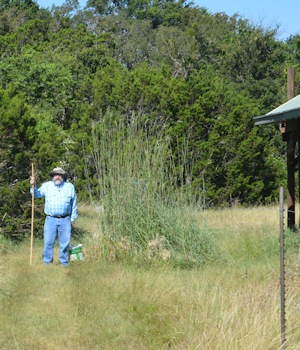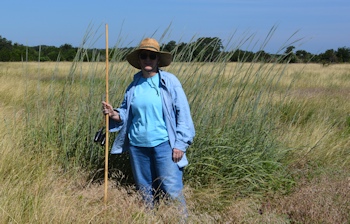 Why it’s called BIG bluestem: the pole is six feet tall
Why it’s called BIG bluestem: the pole is six feet tall
Four grasses form the foundation of the tallgrass prairie biome in the US: Big Bluestem, Switchgrass, Indiangrass, and Eastern Gama. Before this land was broken to the plow, fingers of tallgrass prairie existed here in the wetter lower spots, with midgrass (Little Bluestem, Sideoats Grama, Vine Mesquite, etc) prairie on dryer slopes and shortgrass on the rockiest areas. This is not quite the southernmost bit of tallgrass country, but it’s getting there. When we bought the place, it had been farmed for cotton, corn, sorghum, and then “improved” pasture with non-native grass, and then overgrazed almost to the bare ground–was bare ground in places. One of our goals was to restore native grasses, including the big four. There were patches of Little Bluestem here and there. Larger patches of Indiangrass across the creek. One or two Switchgrass clumps. But no Eastern Gama and no Big Bluestem. We would see patches of it along some county roads, occasionally one in a field, usually a field left fallow for years awaiting development. Twelve years earlier, when we first bought the house and its few acres, we’d established a “grass garden” for native grasses that we began to salvage from construction sites and where narrow country roads were about to be scraped and widened, destroying the plants alongside anyway.
Big Blue is one of those grasses. Each of the stands growing on our place now began as one spade’s worth of root division brought in and planted in the grass garden. One by one, after we bought the 80 acres, 9×9 inch square root divisions were individually planted here and there, seeking those places where they might thrive. Some did well initially; others are still a small clump.
The tallest, above, is in on four feet of black soil over white caliche/rock mix over rock. (We know, from digging fence post holes and the foundation holes for the rain barn nearby.) This area was not farmed as intensively as the rest of the land east of the creek. The rain barn’s 5000 gallon storage capacity means that even in the 5 drought years we could give it a little water every other week or so. It was never heavily watered, but it had some help. It also had a top dressing of aged horse manure last year, in anticipation of a possible El Nino winter. Plenty of rain fell this spring and early summer. Here’s another:
 Two similar stands are in former plowed land & pasture; again, pole is 6 feet
Two similar stands are in former plowed land & pasture; again, pole is 6 feet
This big open field was badly overgrazed, with less than 20# grass coverage when we took it on. It’s suffered erosion, and the soil type and depth vary widely from one side to the other. At the high end, it’s a reddish-brown soil not more than a foot or so deep. Along both the north and south fencelines, where it wasn’t plowed, the black soil I suspect was original is still there in varying depths–deeper to the west, toward the creek, and thinner to the east. It had been terraced, more or less, some time in the past, and then planted with King Ranch Bluestem (non-native grass) as “improved pasture,” but had been overgrazed and badly invaded with nonnative forbs and Ashe juniper. We took hundreds of junipers off the big field, and it’s still a chore to whack the babies that come up from seed.
This stand of Big Blue is a ragged oval about 10 feet by 8 feet now and no longer needs the market stick we had with it for its first years. It suffered badly in the drought (got no supplemental water) but came back strong this year. Last year, before the rains began, it had fewer than ten flowering stalks; now they’re abundant (and not yet open, unlike those of the first picture. Since not all the original root divisions were sourced from the same site (I think we started with four, within a 15 mile radius of here) the difference in flowering times could result from genetic differences in the original sources, or soil conditions.
The other stand in the west grass is a little more robust; it was planted at one side of a stand of vine mesquite (a lower grass that likes more soil moisture) perhaps 50-60 yards from the tallest one and another 50-60 yards from this one.
Of all the things we’ve accomplished, I think I’m happiest to have Big Bluestem back on this land, thriving, coming through the drought, and standing tall. When we moved here, a very old man told me about working as a cowboy in his youth, driving cattle from water to water (the San Gabriel River to the Lampasas, west of here–just west, he said, of present-day US 183), and riding through grass so wall that the seedheads were almost as tall as he was, while in the saddle. This is the grass he remembered seeing one moonlight night, bending in the wind so it looked like waves, he said.
Comment by Doranna — July 22, 2015 @ 11:51 pm
Standing applause for all the changes you’ve nurtured in this land. The Big Bluestem is amazing!
Facing similar issues around here–invasive junipers gone untrimmed by natural grazers and clearing fires, ground gone unfertilized by grazers, ground disturbed by construction (this is fragile, fragile soil) and invasive species everywhere taking advantage of it all. I’ve not been as proactive with grasses, but have mainly worked to stabilize the ground and re-introduce or encourage native growths. Sometimes this means weeding the arroyos of foxtail and pepperweed, sometimes it means trying to translplant things from endangered spots to new spots. Pruning the juniper and deadwood is an ongoing project, metered by the seasons and my health. I wish my success rate was higher on all counts!